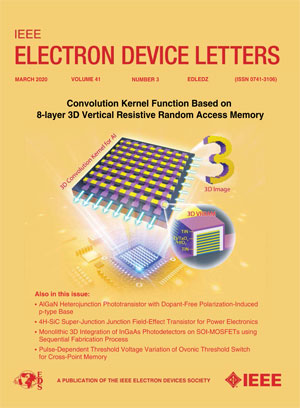2.7 kV E-Mode Multichannel GaN-on-Si Based on p-Type NiO/SiO2 Junction Tri-Gate
IF 4.5
2区 工程技术
Q2 ENGINEERING, ELECTRICAL & ELECTRONIC
引用次数: 0
Abstract
In this work, an E-mode multichannel HEMT is demonstrated based on p-type NiO/SiO2 as a gate stack to form a junction tri-gate structure. NiO provides a high hole concentration (基于p型NiO/SiO2结三栅极的2.7 kV e型多通道GaN-on-Si
在这项工作中,展示了基于p型NiO/SiO2作为栅极堆栈形成结三栅极结构的e模多通道HEMT。NiO提供高空穴浓度($\approx ~10^{{19}}$ cm ${}^{-{3}}$),导致栅极下多个2DEG通道中的电子有效耗尽。薄的SiO2层作为牺牲层,防止在NiO沉积过程中损坏鳍片。因此,与单独使用SiO2相比,e模式工作可以通过3倍大的三栅极鳍片实现,${V}_{\text {th}}$为0.7 V ($1~\mu $ a /mm),可忽略的阈值电压滞后($\Delta {V}_{\text {th}}$为0.05 V),以及2.8 m的导通电阻(${R}_{\text {ON}}$) $\Omega \cdot $ cm2,栅极-漏极分离(${L}_{\text {GD}}$)为$20~\mu $ m。此外,器件表现出优异的断开状态特性。包括击穿电压(${V}_{\text {br}}$)为2.7 kV,开/关电流比为$10^{{9}}$,展示了p-NiO/SiO2栅极堆叠用于高性能e模功率器件的潜力。
本文章由计算机程序翻译,如有差异,请以英文原文为准。
求助全文
约1分钟内获得全文
求助全文
来源期刊

IEEE Electron Device Letters
工程技术-工程:电子与电气
CiteScore
8.20
自引率
10.20%
发文量
551
审稿时长
1.4 months
期刊介绍:
IEEE Electron Device Letters publishes original and significant contributions relating to the theory, modeling, design, performance and reliability of electron and ion integrated circuit devices and interconnects, involving insulators, metals, organic materials, micro-plasmas, semiconductors, quantum-effect structures, vacuum devices, and emerging materials with applications in bioelectronics, biomedical electronics, computation, communications, displays, microelectromechanics, imaging, micro-actuators, nanoelectronics, optoelectronics, photovoltaics, power ICs and micro-sensors.
 求助内容:
求助内容: 应助结果提醒方式:
应助结果提醒方式:


